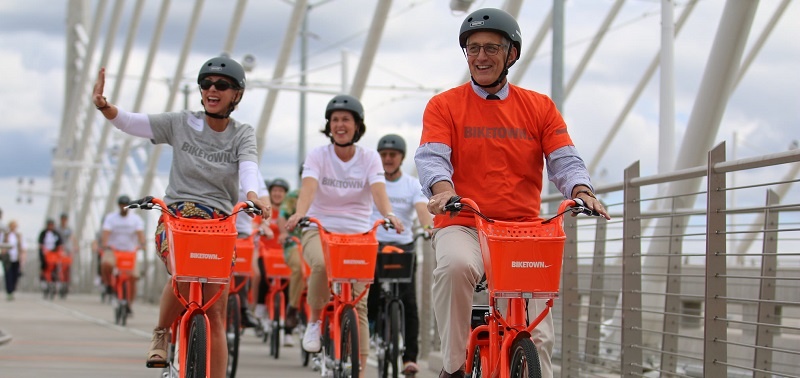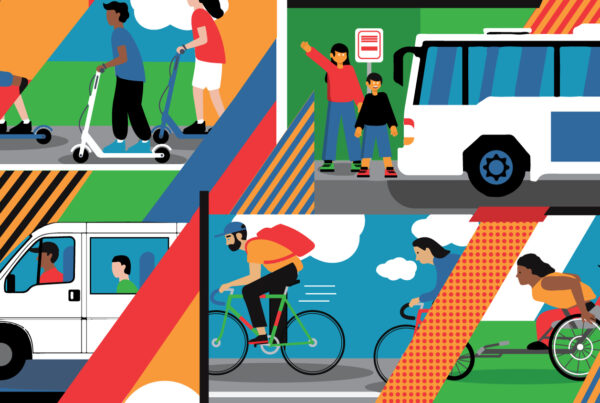Over the past several years, public-private partnerships (P3s) have played an increasingly important role in helping cities across the U.S. realize the benefits of new, flexible forms of shared mobility such as bikesharing, carsharing and ride-hailing.
A recent webinar conducted by the Shared-Use Mobility Center (SUMC) on Creating & Implementing Public-Private Shared Mobility Partnerships brought together leading transportation experts whose experiences demonstrate the power of collaboration in solving transportation challenges.
The webinar was moderated by SUMC Executive Director Sharon Feigon and featured:
- Justin Holmes, Director of Corporate Communications & Public Policy, Zipcar;
- Dani Simons, Director of Corporate Communications & External Affairs, Motivate;
- Paige Tsai, Transportation Policy & Research Associate, Uber; and
- Marla Westervelt, Senior Transportation Planner, Policy and Innovation, Los Angeles County Metropolitan Transportation Authority’s Office of Extraordinary Innovation.
While there is no one-size-fits-all solution when it comes to creating effective P3s, the speakers drew from their own experiences to offer real-life examples and discuss what it takes to make such arrangements successful, from formulating ideas to structuring contracts and managing procurement.
How (and Why) to Create Successful P3s
Last year, SUMC conducted a study for the Transportation Research Board that found the more people use shared modes, the more likely they are to use public transit, own fewer cars and spend less on transportation overall. P3s can help cities create varied, rich transportation ecosystems that support car-free and car-lite living and the “super-sharer” lifestyle.
While the benefits of P3s are often clear, creating a successful partnership can be a challenge. Here are 10 tips from the webinar’s presenters that cities can use to create a successful P3:
- Make sure everyone starts with a common understanding of the project’s parameters. It’s critical that all parties start with a shared understanding of the problem or issue to be addressed, the overarching goals of the program and the performance measures. As Sharon explained, “The more transparent you are about what you want to achieve, the easier it is to get there.”
- Think about what everyone does best and assign roles accordingly. Cities should set the ground rules by codifying public policy goals around equity, accessibility and hiring requirements. They should also frame public expectations. The private sector, on the other hand, should focus on its strengths, such as sponsorship, marketing and operations.
- Leverage the private sector to accelerate the pace of change. Part of the advantage of engaging private companies is the ability to move quickly and trim back the proverbial red tape. P3s can be a great catalyst to help drive a new concept.
- Share the risks and rewards. Cities should structure P3s to ensure that risks (and rewards) from the partnership are shared by both parties. The public sector should not have to bear an undue burden portion of the financial and operational risks for a pilot project.
- Get creative. Creativity is vital in designing services and developing ideas. Feel free to look for examples elsewhere, but don’t be afraid to take a shot at developing a unique solution that works for your city.
- Invite the private sector to come to you with ideas. For instance, Los Angeles Metro’s Office of Extraordinary Innovation has established an “unsolicited proposals” policy for private companies. Any firm with an idea for a better way to design, finance, build, deliver, or operate Metro’s services is welcome to submit a proposal at any time.
- Use pilot projects to test concepts. Pilot projects can help cities experiment, iterate and launch new services before committing to operating a new mobility service at scale. Framing a project as a pilot can also help address potential roadblocks and manage expectations.
- Be intentional in project design and rollout. The more clearly cities can communicate with stakeholders about the parameters and timeline of a project, the better. Be sure to think through, and share, your long-term vision.
- Communicate early and often with labor. Labor laws and regulations are important to the success of just about any transportation project. Avoid missteps by keeping in regular communication with government employees and union representatives.
- Celebrate your success. Don’t keep your project a secret—let others know about your work, the challenges you experienced and the ultimate outcome. Maybe we’ll see you on SUMC’s next webinar!
Examples of Existing P3s
The presenters also discussed a wide range of recent successful P3s relating to bikesharing, carsharing, ride-hailing and more. Examples included:
Summit, NJ Partnership with Uber to Subsidize Rides to and from Commuter Rail Station
City: Summit, NJ
Date: October 2016
The City of Summit, New Jersey has partnered with Uber to subsidize rides to and from the commuter rail station that connects Summit to nearby New York City. The pilot project was developed as an alternative to building a new parking lot, with the aim of easing the congestion and parking difficulties commuters face at the rail station. The program will provide flat $2 rides for commuters traveling to and from the rail station, with the City of Summit paying the difference between the $2 fare and the actual rate charged by Uber. The total of $4 that commuters will pay to travel to and from the station is the equivalent of what a daily parking pass currently costs at the station.
Boston MBTA Subsidizing TNC Rides to Aid in Paratransit Efforts
City: Boston, MA
Date: September 2016
The Massachusetts Bay Area Transportation Authority (MBTA) has launched a pilot project with Uber and Lyft to provide door-to-door service for qualified users of the region’s paratransit service. Riders pay $2 for a ride with the transit authority subsidizing the rest, up to $13. The service is designed to provide users reduced fares, lower wait times, same-day booking and faster trips compared to traditional paratransit service. Uber and Lyft both have wheelchair accessible vehicles, however drivers are not required to leave their vehicles or perform services not usually provided by Uber or Lyft. Additionally, for customers without access to smartphones, Lyft pilot customers can use a phone-in option and a limited number of Uber customers can utilize Uber-provided smartphones for use on a limited basis to book trips.
City of Portland Partnership with Motivate to Launch BIKETOWN System
City: Portland, OR
Date: July 2016
The City of Portland launched its bikeshare system in partnership with operator Motivate and corporate sponsor Nike. Nike committed to a $10 million sponsorship to cover acquiring, launching and operating the system. Additionally, The Portland Bureau of Transportation received a $2 million federal grant which required a 10.27% match, which is covered by the Nike commitment. The system also launched with the lowest price point of any major bikeshare system in the country, as well as with a comprehensive equity plan to ensure all Portlander’s benefit from the system.
Seattle Free-Floating Carshare Ordinance
City: Seattle, WA
Date: January 2016
The initial success of a 350-space on-street parking pilot in 2013 led Seattle’s city council to further expand the program in January 2015, passing new legislation that extended the pilot’s service area and required new operators to serve the entire city in exchange for an increased cap of 750 vehicles per operator. Two years after the initial pilot, more than 70,000 Seattle residents are using one-way carsharing, which has resulted in thousands of people discarding their private autos, according to operator car2go. Additionally, the city estimates it will bring in $2.2 million in permit revenue in 2015 with an estimated 1,300 free-floating vehicles, and $3.4 million in 2016 with 2,000 vehicles.
More information on these and other case studies is available in SUMC’s Shared Mobility Policy Database, now home to more than 800 relevant policies, plans, RFPs and more. You can also view the speakers’ PowerPoint presentations and access the recorded webinar here: Creating & Implementing Public-Private Shared Mobility Partnerships.
Finally, to learn about future SUMC webinars and receive a weekly digest of news and resources about shared mobility, don’t forget to subscribe to SUMC’s newsletter.
Image credit: Felicity J. Mackay, Portland Bureau of Transportation


